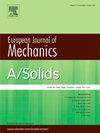Atomistic investigation of interface adherence mechanism of structural indenter nanocoining single crystal aluminum
IF 4.4
2区 工程技术
Q1 MECHANICS
引用次数: 0
Abstract
The utilization of nanoimprint technology has become widespread in various industries. Nanocoining, a new type of nanoimprinting technology, is essentially graphic copying. Ensuring the indenter's accuracy and the transfer's integrity is crucial. Structured tool (ST)-metal workpiece interface commonly exists in adherence phenomenon during the nanoimprint. To reduce the adherence of workpieces in ST, it is remarkable to illustrate the adhesion mechanism. The molecular dynamic simulation model for indenting aluminum with a diamond ST indenter was established, and the influence of critical process parameters on adhesion, including the indenter geometry, indenter temperature, and indenter speed, was investigated. The results demonstrate that various factors significantly influence adhesion, including the van der Waals force, surface energy, temperature, mechanical embedding, diffusion, and holding stage. The mechanism of adhesion can be composed of three parts: the mechanical embedding caused by the large range of cavity filling of the indenter, the slow thermal diffusion and thermal migration of aluminum atoms along the indenter and the combined effect of thermal-tensile stress in the demolding process. The intensity of adhesion is affected by several factors, namely the degree of plastic deformation during loading and unloading, atomic thermal migration caused by system temperature, and the magnitude of tensile stress during the demolding stage. The geometry of the indenter exerts the most significant influence on the van der Waals force, surface energy, imprinting force, and unloading force. Additionally, the omission of the holding stage during processing contributes to a reduction in adhesion. This study provides atomic-level insights into the adhesive properties of metallic materials in the nanocoining process.
结构压头纳米压入单晶铝的界面粘附机理的原子学研究
纳米压印技术已在各行各业得到广泛应用。纳米压印是一种新型的纳米压印技术,其本质是图形复制。确保压头的精度和转移的完整性至关重要。在纳米压印过程中,结构工具(ST)-金属工件界面通常存在粘附现象。为了减少 ST 中工件的粘附,说明粘附机理是非常重要的。建立了用金刚石 ST 压头压入铝的分子动力学模拟模型,并研究了压头几何形状、压头温度和压头速度等关键工艺参数对附着力的影响。结果表明,范德华力、表面能、温度、机械嵌入、扩散和保持阶段等各种因素都会对附着力产生重大影响。粘附机理可由三部分组成:压头空腔填充范围大导致的机械嵌入、铝原子沿压头的缓慢热扩散和热迁移以及脱模过程中的热拉伸应力的共同作用。粘附强度受几个因素的影响,即加载和卸载过程中的塑性变形程度、系统温度引起的原子热迁移以及脱模阶段拉伸应力的大小。压头的几何形状对范德华力、表面能、压印力和卸载力的影响最大。此外,在加工过程中省略保持阶段也会导致附着力降低。这项研究从原子层面揭示了金属材料在纳米压印过程中的粘附特性。
本文章由计算机程序翻译,如有差异,请以英文原文为准。
求助全文
约1分钟内获得全文
求助全文
来源期刊
CiteScore
7.00
自引率
7.30%
发文量
275
审稿时长
48 days
期刊介绍:
The European Journal of Mechanics endash; A/Solids continues to publish articles in English in all areas of Solid Mechanics from the physical and mathematical basis to materials engineering, technological applications and methods of modern computational mechanics, both pure and applied research.

 求助内容:
求助内容: 应助结果提醒方式:
应助结果提醒方式:


